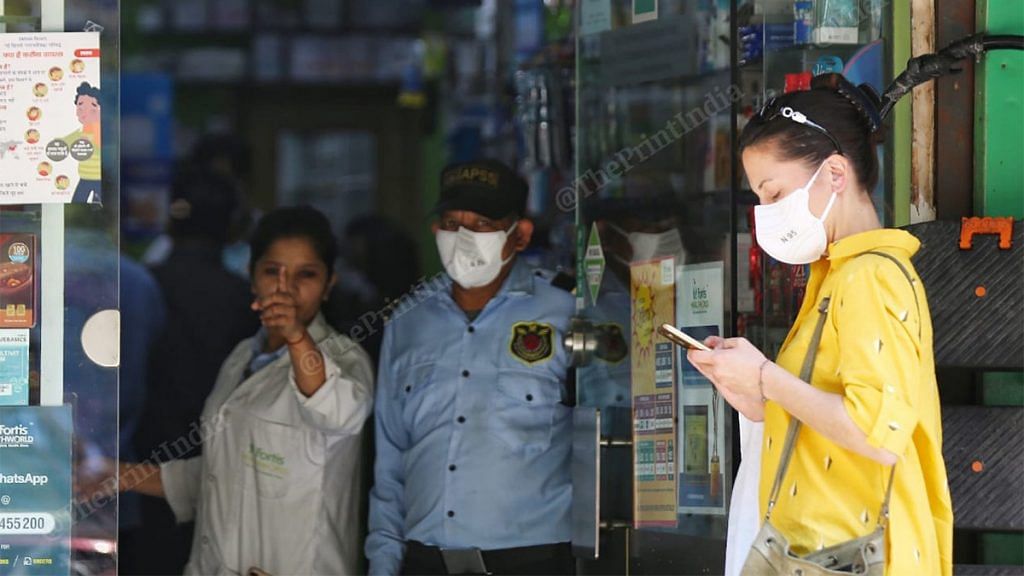New Delhi: India will see community transmission of COVID-19, but its efforts to effectively screen and quarantine the patients will determine when that occurs, an Indian Council of Medical Research (ICMR) study has found.
Using mathematical models of disease transmission, the study aimed to find if it’s possible to prevent and delay local outbreaks of the novel coronavirus through restrictions on travel from abroad, and quarantine of patients
The paper offered two scenarios — optimistic and pessimistic — to present its projections of the spread of the disease in the four cities of Delhi, Mumbai, Bengaluru and Kolkata.
In the optimistic scenario, where half of the symptomatic passengers would be identified and quarantined and asymptomatic patients would not be spreading the disease, the disease prevalence would reduce by 62 per cent, said the paper.
However, in the pessimistic scenario, where asymptomatic patients are half as infectious as symptomatic patients, the impact of quarantining half symptomatic passengers would only be 2 per cent.
This can be worrisome for India as its current strategy is focussed on testing symptomatic patients with travel history, their high-risk contacts and health workers.
Nearly a month after it was accepted, the paper was published in the Indian Journal of Medical Research Monday. However, its findings were based on the scenario in which the transmission was from China alone, and on airport screenings and subsequent quarantining of symptomatic patients.
While the paper is now dated by a month, it could tell the impact of social distancing and quarantine, co-author and ICMR member Tarun Bhatnagar told ThePrint.
Almost 30 states with 548 districts in India have been under complete lockdown since Monday to stop the spread of coronavirus. The country has recorded 471 confirmed cases as of Tuesday, with the figures having more than doubled over the last four days.
Also read: Sitharaman promises economic package ‘soon’, but eases norms for businesses and taxpayers
‘Flatten the curve’
Tarun Bhatnagar, who is also a scientist at the National Institute of Epidemiology, said, “India will be able to flatten the curve if India can home quarantine enough number of symptomatic patients as early as possible.”
Just improving screening and quarantine can delay the peak of epidemic from 35 days to 600 days, he said.
According to the optimistic scenario projected in the paper, with quarantine efforts towards symptomatic patients in three days in Delhi, the number of cases would be 20,000 in two years. However, if the asymptomatic patients spread the disease, the numbers could be as high as 1.5 million symptomatic cases in six months.
While the study did not give estimates of beds and ventilators required, it said that about 5 per cent of the infected cases would need intensive care and half of them would need ventilation.
The government is doing all it can to increase the capacity of hospitals but even if we ramp up the capacity, we may not be able to meet the number of patients, said Bhatnagar.
India’s wider testing policy — testing asymptomatic high-risk contacts of coronavirus patients and testing pneumonia patients — will help in finding more COVID-19 patients, he said.
Just screening and quarantining measures would be insufficient to delay the outbreak by weeks or longer. “As a public health measure, the health system and community preparedness would be critical to control any impending spread of COVID-19 in the country,” the paper said.
Also read: At current rate, India can see 30,000 COVID-19 deaths by May, no hospital bed by June: Data
Screening the asymptomatic
In order to delay the transmission of coronavirus, airport arrival screening would need to screen as well as identify even asymptomatic passengers, the paper said.
It added that airport screening is not sufficient to detect coronavirus-infected passengers as thermal screening would spot only 46 per cent of them.
Without a rapid test for the virus, the only way to reach all the asymptomatic passengers would be to isolate and quarantine all of them from the specified COVID-19 origin airports. This, however, would be impractical, the paper said.
“Resources may be better spent on the mitigation of infection in the community,” it added.
India has screened 1.5 million passengers at the airport, according to the Union health ministry website.
While India had quarantined those evacuated from Wuhan in China and the Diamond Princess cruise, other international arrivals were sent for ‘self quarantine’ at home if they were asymptomatic.
But ICMR director general Balram Bhargava said last week that the authorities are getting more flexible about quarantining guidelines because of the large number of passengers.
Even those recently evacuated from Italy were screened and while older passengers were isolated, younger patients were sent home for self-quarantine, Damu Ravi, additional secretary in the Ministry of External Affairs, said last week.
India banned arrivals from all international airports only on 22 March.
‘Lockdown will help’
Speaking to ThePrint, Bhatnagar said lockdowns, like India has just ordered, can help delay the peak and the intensity of the spread.
China, which was under lockdown for two months, has now shown no indigenous cases. India may not need two-three months to stop the disease transmission, as it did not have the reservoir or transmission as China did, he said.
“We now need to find if there are clusters of transmission and then focus interventions in those clusters as the days go by,” added Bhatnagar.
Also read: Modi govt to bring back 400 Indians from Iran in 2 batches, first one will arrive today
